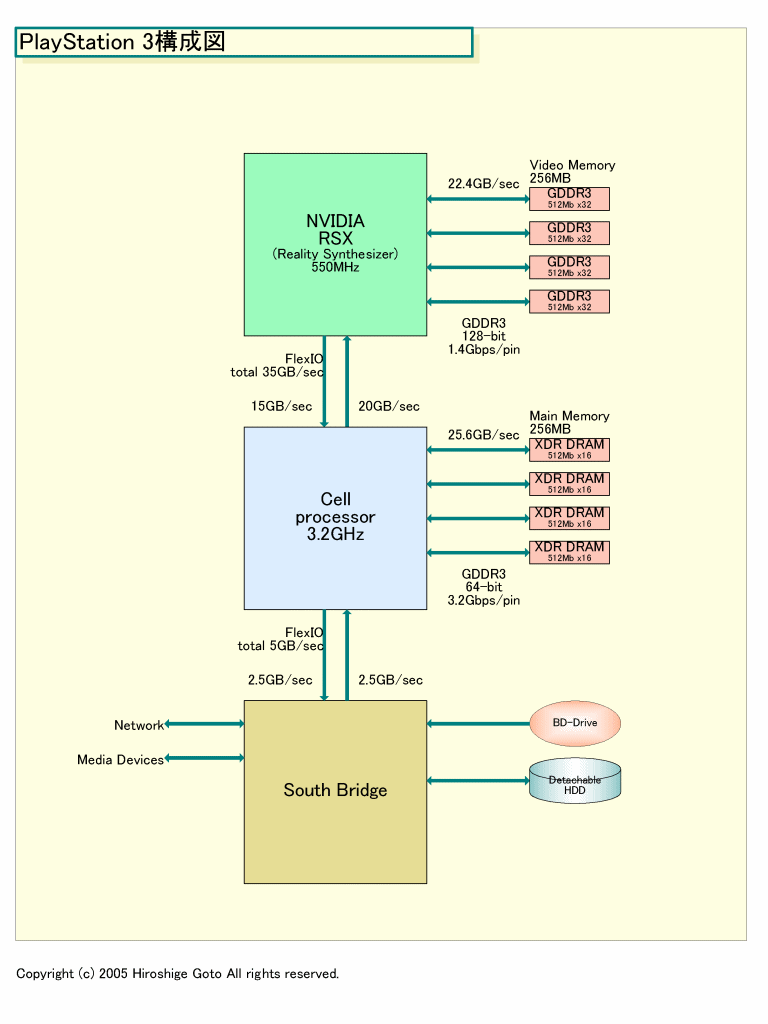Helleo every body, i'm a 29 years old newbie.
I'm no more a gamers but i'm still please to follow hardware news.
A little thanks to the mods, who keep the forum interessenting.
I 've read all the topic concerning PS3 and XBOX360.
I've hard time understanding some very techies post but i've gone my ways.
I think a lot of person wizer and with a LOT MORE knoledge than my seem to keep things in a kind of war numbers.
What I want is to forget numbers and make some assomptions on the way chips are implemented in PS3 architecture (sorry for english, i DO my best).
The facts:
1 cell
1 rsx
256 mb xdr
256 mb gdr
We know that the two main chip (don't consu=ider sb as a main chip) are able to adress data anywhere on the 2 memory polls.
Some of you seem to see memories transaction that way:
X ------- Cell -------- G
D | D
R -------- RSX -------- R
I think in reality it's a lot a more linear
For what i've understand the heart of the PS3 is nor CELL or the RSX bus the Rambus BUS technology. unified bus architecture?
I see the the things working that way:
XDR-----XIO----EIB-----FlexIO----GDR
| | |
PPE PPE+PSE RSX
or CELL (based on linux devs articles)
EDIT( i can' t get a good spacing... so cell under XIO,EIB,FIO and RSX under FIO)
So my thinking is that the Ps3 is "architected" (really sorry for bad english) ALONG the Bus provide by RAMBus technology.
For ly it's teh only way the cell can access the gdr.
As an exemple the XBOX360 seem constructed AROUND the parent die.
So What?
Anybody seem concern with X4 and other we don't really know until more PR.
the main difference in G70 and RSX seems to be the implemention of some kind of FlexIO or weird memory controleur on the RSX.
So i want know what more knoledgeable than me think of my way understanding the PS3.
And if i'm not to wrong have them doing more guessing on RSx and PS3.
(NO FANBOYS)
I'm no more a gamers but i'm still please to follow hardware news.
A little thanks to the mods, who keep the forum interessenting.
I 've read all the topic concerning PS3 and XBOX360.
I've hard time understanding some very techies post but i've gone my ways.
I think a lot of person wizer and with a LOT MORE knoledge than my seem to keep things in a kind of war numbers.
What I want is to forget numbers and make some assomptions on the way chips are implemented in PS3 architecture (sorry for english, i DO my best).
The facts:
1 cell
1 rsx
256 mb xdr
256 mb gdr
We know that the two main chip (don't consu=ider sb as a main chip) are able to adress data anywhere on the 2 memory polls.
Some of you seem to see memories transaction that way:
X ------- Cell -------- G
D | D
R -------- RSX -------- R
I think in reality it's a lot a more linear
For what i've understand the heart of the PS3 is nor CELL or the RSX bus the Rambus BUS technology. unified bus architecture?
I see the the things working that way:
XDR-----XIO----EIB-----FlexIO----GDR
| | |
PPE PPE+PSE RSX
or CELL (based on linux devs articles)
EDIT( i can' t get a good spacing... so cell under XIO,EIB,FIO and RSX under FIO)
So my thinking is that the Ps3 is "architected" (really sorry for bad english) ALONG the Bus provide by RAMBus technology.
For ly it's teh only way the cell can access the gdr.
As an exemple the XBOX360 seem constructed AROUND the parent die.
So What?
Anybody seem concern with X4 and other we don't really know until more PR.
the main difference in G70 and RSX seems to be the implemention of some kind of FlexIO or weird memory controleur on the RSX.
So i want know what more knoledgeable than me think of my way understanding the PS3.
And if i'm not to wrong have them doing more guessing on RSx and PS3.
(NO FANBOYS)

